Rare Earth Elements Discovered in Sweden
Recently, Sweden’s state-owned mining company LKAB has discovered Europe’s largest deposit of rare earth metals.
Rare earth metals
• They are a set of 17 metallic elements.
• These include the 15 lanthanides on the periodic table in addition to scandium and yttrium that how similar physical and chemical properties to the lanthanides.
Significance of rare earth metals
• There are many applications in consumer electronics, computers and networks, communications, clean energy, advanced transportation, healthcare, environmental mitigation, and national defence, among others.
▪ Scandium is used in televisions and fluorescent lamps
▪ Yttrium is used in drugs to treat rheumatoid arthritis and cancer.
• Rare earth elements are also used in space shuttle components, jet engine turbines, and drones.
▪ Cerium, the most abundant rare earth element, is essential to NASA’s Space Shuttle
Programme.
• Moreover, the push for switching from internal combustion cars to electric vehicles has also led
to a rise in demand for rare earth.
Significance of the discovery
• The store, situated in Kiruna located in the northern region of Sweden, holds a stockpile of over
1 million metric tons of rare earth oxides.
• This discovery bolsters Europe's ambition to rely less on imported raw materials needed for the
green transition.
• Currently, no rare earths are mined in Europe and it mostly imports them from other regions
(98% from China).
• The discovery can also prove to be a significant turning point not just for the EU but also for other
western countries as they have been trying to reduce their reliance on China for the import of
these rare earth elements.
Monopoly of China
• China has over time acquired global domination of rare earths, even at one point, it produced 90% of the rare earths the world needs.
• Today, however, it has come down to 60% and the remaining is produced by other countries, including the Quad (Australia, India, Japan and United States).
• Since 2010, when China curbed shipments of Rare Earths to Japan, the US, and Europe, production units have come up in Australia.
• Even so, the dominant share of processed Rare Earths lies with China.
Minerals Security Partnership (MSP)
• The US and 10 partners — Australia, Canada, Finland, France, Germany, Japan, South Korea, Sweden, the United Kingdom, and the European Commission — have come together to form the MSP.
• The new grouping, industry insiders say, could focus on the supply chains of minerals such as Cobalt, Nickel, Lithium, and also the 17 ‘rare earth’ minerals.
• The alliance is seen as primarily focused on evolving an alternative to China, which has created processing infrastructure in rare earth minerals and has acquired mines in Africa for elements such as Cobalt.
Rare earth metals in India
• India has 6% of the world’s rare earth reserves, it only produces 1% of global output, and meets most of its requirements of such minerals from China.
• Indian Rare Earths Limited (IREL) is majorly responsible for mining and extraction of primary mineral that contains Rare Earth Elements: monazite beach sand, found in many coastal states.
• IREL’s prime focus is to provide thorium — extracted from monazite — to the Department of Atomic Energy.
